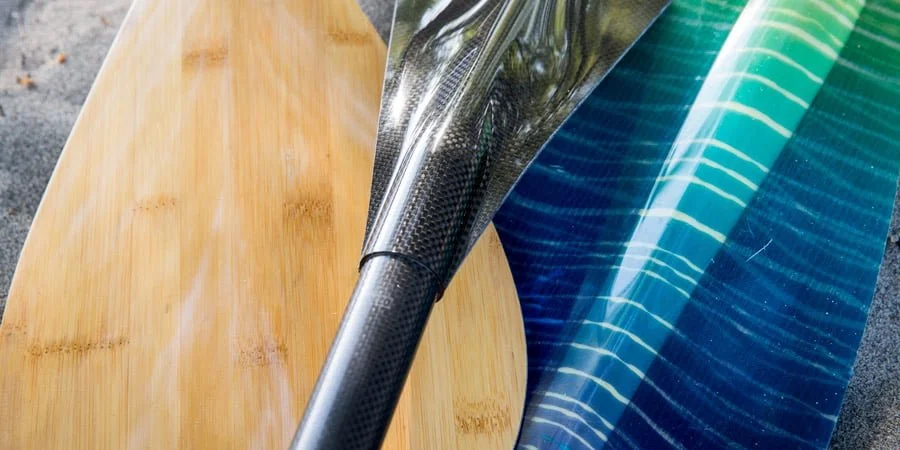Don’t forget your paddle
Paddles are a crucial piece of your kit and can make a significant difference to your performance. Just like the size and shape of boards have evolved, so has the development of the paddle. SUP paddles are available in a range of materials including, aluminum, fiberglass, or carbon fiber and most come equipped with a nylon blade. Carbon blades offer better performance, but they are also the most expensive.
You can buy the best board in the world, but you won't get very far without a good paddle. Stand-up paddleboarding (SUP) will be a lot more enjoyable if you invest in a good paddle that fits your body and paddling style. Does this imply that you must purchase a top-of-the-line paddle? Certainly not. Consider the following aspects while selecting a SUP paddle:
Paddle length: Choosing the correct paddle size is critical for maintaining optimal paddling form and efficiency. It's critical to purchase a paddle that is the proper length for you. A paddle that is too long will be difficult to use, while a paddle that is too short will force you to lean over in an awkward position in order to get the blade into the water.
To choose the right size paddle for recreational touring:
Stand the paddle up vertically so the tear-drop-shaped blade is touching the ground.
Reach an arm up above your head and notice where it lands on the paddle.
With a properly sized paddle, the T-grip handle will rest in the bend of your wrist.
If you’re ordering a paddle online, add about 8–12 inches to your height and choose a paddle of that length.
If you’ll be doing something other than recreational touring, such as surfing or racing, you may need a different length. SUP surfers usually choose a paddle that’s a bit shorter than touring length, while racers typically go a bit longer.
Paddles with adjustable lengths are popular due to their adaptability. They make it simple to figure out what length works best for you, and you can fine-tune it for surfing, touring, or racing. Another advantage is that you can share your paddle with friends and family members who are shorter or taller. Many manufacturers provide the same paddle in a variety of adjustment ranges, so make sure the one you choose meets your requirements.
Paddles with a fixed length: Some individuals prefer fixed-length, non-adjustable paddles because they are lighter and stiffer without the adjusting mechanism. Some fixed-length paddles are made to be chopped down to the exact length you require. Try out a few various lengths before investing in a fixed-length paddle.
If you’re racing or setting out on long tours, you’ll appreciate a light paddle.
Most paddlers can achieve several thousand strokes in only a few hours. Lifting a heavy paddle repeatedly can be exhausting, which is why most experienced paddlers would get the lightest paddle they can afford. The stiffness of your paddle is also determined by the material it is made of. A stiff paddle will transfer the power of your stroke more effectively. The materials used to create a SUP paddle have an impact on the paddle's weight and rigidity. In general, a lighter paddle is desirable, but keep in mind that lighter paddles usually cost more.
Aluminum Paddle with Nylon Blade: Aluminum paddles with nylon blades are the most affordable paddles. They are also the heaviest but still perform well.
Fiberglass Paddle with Nylon Blade: Fiberglass paddles are lighter than aluminum paddles and are often stiffer. They are slightly more expensive than aluminum paddles but offer a good compromise between the price of a carbon paddle and the performance of an aluminum paddle.
Carbon Fibre Paddle with Nylon Blade: these paddles are stiff and light, and offer great performance. Ideal for long-distance paddling, but they can do it all. If money is no object, look for a carbon fibre paddle.
Carbon Fibre Paddle with Carbon Blade: the most expensive, but the best performers. These paddles are for hardcore paddlers who paddle long distances or compete in SUP racing. These don’t usually break down, so they are not ideal for travel.
Do you need a light paddle?
How much do you want to spend?
Lightweight materials, like carbon and fibreglass, cost more than heavier ones, like aluminum and plastic.Stiff paddles can be jarring to your muscles and joints.
If you have had previous shoulder, arm or wrist injuries, you may want a paddle with some flex.
Size, shape, and offset of the blades: The paddle blade's size, shape, and offset determine how it glides through the water. You'll select a blade depending on your paddling style, body type, and personal choice. Generally, the larger you are, the larger your blade should be.
Carbon Fibre Paddle used with a race board
There isn't a hard and fast rule for selecting the size of paddle blade you require. Based on the type of paddling you do and other criteria like your body type, you'll probably acquire a preference for a certain size blade over time.
If you're new to SUP, though, follow this advice: Your blade can be as big as you want it to be. This is due to the fact that larger paddlers are more likely to be able to move a larger blade through the water.
Here are some approximate surface area recommendations based on body weight:
Small/medium body types (less than 150 lbs.): 80–90 sq. in.
Medium/large body types (150 – 200 lbs.): 90–100 sq. in.
Large/X large body type (200+ lbs.): 100–120 sq. in.
Large blades are more powerful: Large blades move a lot of water, allowing you to perform forceful strokes to quickly bring your board up to speed. If you're a SUP surfer, for example, a larger blade (100–120 sq. in.) will allow you to swiftly position your board to catch a wave by taking a few forceful strokes.
Smaller blades are more efficient: A small blade moves less water each stroke, but it's easier to drag the blade through the water than a larger blade, thus each stroke requires less effort. If you're a SUP racer or long-distance tourer who wants to save energy for the long haul, a blade in the 80–90 sq. in. range can be beneficial. If you paddle with a high cadence or need to be gentle on your joints and muscles, a short blade is also a preferable alternative.
The design of the paddle blade has an impact on how it goes through the water and how strong it is. Although the performance variations between blade forms are minor, you may develop a preference for one shape over another as you gain expertise.
Tear-drop: Because this form is largest at the bottom, you're immediately moving water with the majority of the blade's surface area when you put it in the water. SUP surfers and paddlers who prefer a slower-cadence, more forceful stroke-like to use a large surface area, which results in a powerful stroke.
Rectangular blades are narrower at the bottom than tear-drop blades, resulting in less surface area being engaged when the blade is first dipped in the water. As a result, these blades can produce a smoother stroke and are therefore less taxing on your body. They also make it possible to use a higher cadence stroke.
Blade Offset
The degree to which the blade bends forward from the shaft is referred to as offset. The size of that angle influences how vertical the blade is as it passes through the water, and thus how much power you receive out of each stroke. Unless you prefer examining the finer details of your gear, you don't need to spend much time evaluating offset angles. As a result, below are some broad offset recommendations based on various paddling styles:
The ideal angle for SUP surfing is around 7 degrees.
Approximately 10 degrees for all-around paddling/mixed use
For SUP racing, the angle should be around 12 degrees.
Source: Werner Paddles





